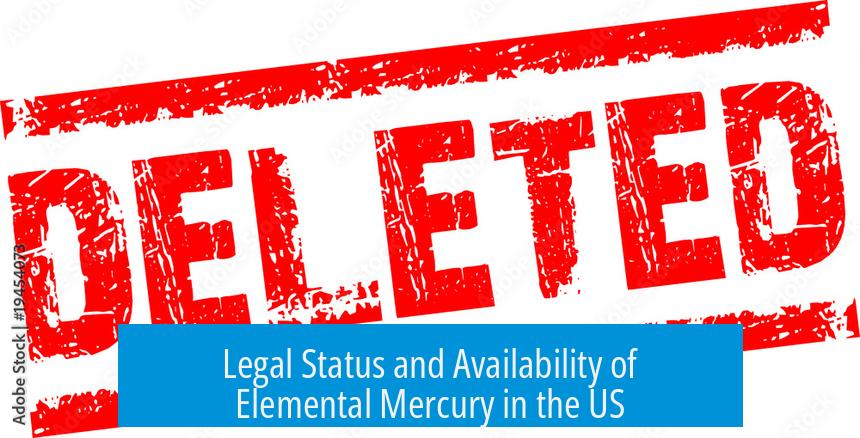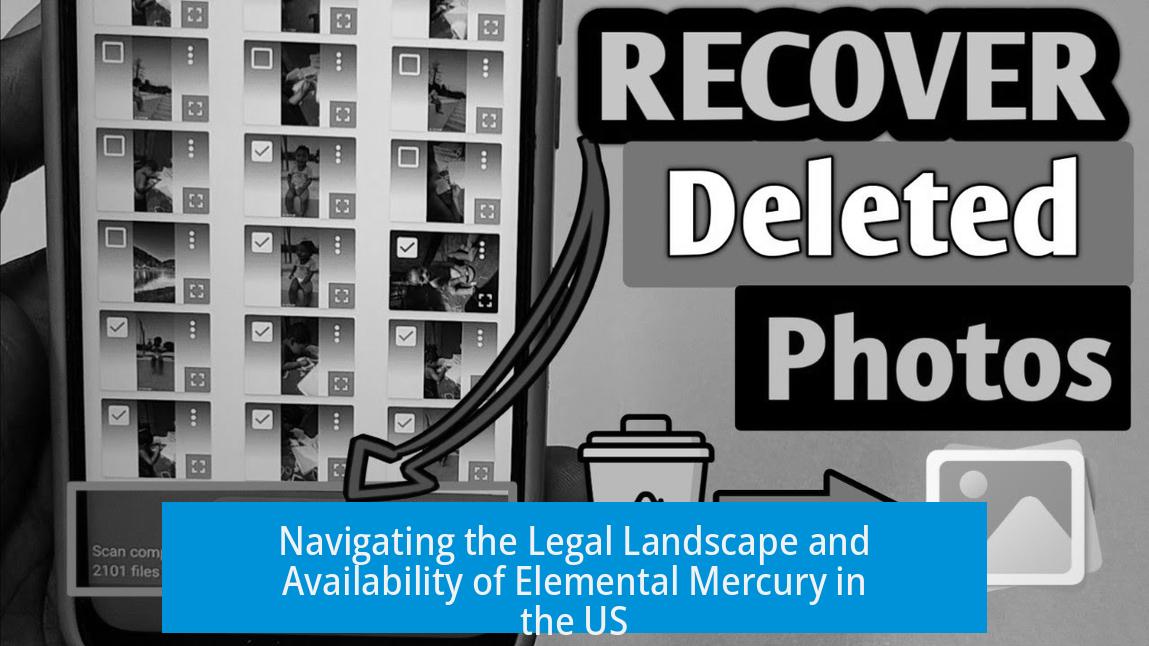Legal Status and Availability of Elemental Mercury in the US

Elemental mercury is not readily available for sale in the United States due to strict legal restrictions. The Mercury Export Ban Act of 2008 restricts the commercial availability of metallic mercury. It aims to reduce supply domestically and internationally to limit its use.
Mercury Export Ban Act
- Signed into law on October 14, 2008
- Prohibits federal agencies from selling or distributing elemental mercury
- Reduced mercury commerce to minimize health and environmental impacts
- Law effective from January 1, 2013, for state-level compliance
The EPA enforces these regulations to curb mercury’s spread in commerce and reduce reliance on mercury-based products.
Common Sources of Mercury Outside Commercial Sale
While elemental mercury is rarely sold openly, it can still be found in older items and legacy uses.
Household and Industrial Sources

- Old thermometers and thermostats contain small quantities of mercury
- Historical dental amalgams once used mercury extensively
- Laboratories previously used mercury for calibrating volumetric equipment
Many labs have shifted away from mercury due to regulatory burdens and safety risks. Mercury spills pose significant hazards and cleanup challenges.
Other Possible Origins
- Scrap metal collections may contain mercury from dismantled devices
- Mining activities, especially in specific states like California, can yield natural mercury deposits
Hazards and Regulatory Challenges
Mercury presents health risks such as neurological damage through vapor inhalation and environmental contamination. Its toxicity drives heavy regulation.
Handling mercury requires safety protocols and proper disposal methods. The regulatory framework imposes restrictions to prevent accidental exposures and ecological harm.
Historical Context and Changes in Usage

Earlier decades saw mercury used more openly, including in classrooms for educational demonstrations. Since then, awareness of the risks has led to widespread removal from everyday use.
Modern practices avoid mercury unless absolutely necessary and under strict regulatory control.
Practical Recommendations
- Obtaining mercury through legal channels is difficult and tightly regulated
- Repurposing mercury from old devices should only be done by trained professionals
- Proper authorization and safe handling procedures are essential to avoid health risks
- Environmental laws govern mercury disposal to mitigate contamination
Key Takeaways
- Elemental mercury sale is highly restricted in the US due to the Mercury Export Ban Act.
- Mercury is still present in old thermometers, thermostats, and legacy laboratory use.
- Health and environmental hazards drive stringent regulatory controls.
- Mercury use has declined significantly since the 1970s amid safety concerns.
- Legal acquisition is challenging; professional handling and compliance with laws are vital.
Why Is Elemental Mercury So Hard to Find in the US?
Elemental mercury is nearly impossible to buy legally in the US today. Thanks to the Mercury Export Ban Act of 2008, the government clamps down hard on its sale and distribution. The law’s core aim is simple: reduce mercury’s presence in the market to protect people and the environment. Since January 1, 2013, federal agencies can’t buy or sell it, and commercial suppliers face strict limits. The message? Mercury is out of easy reach for just anyone.
So why this crackdown? Mercury is toxic, volatile, and can linger harmfully in ecosystems. Its ability to bioaccumulate means small exposures build up in fish, animals, and humans. Reducing supply cuts risks right at the source.
The Mercury Export Ban Act: A Brief Overview
Passed in 2008, the Mercury Export Ban Act targets domestic and international markets. It doesn’t just pretend mercury doesn’t exist; it halts its legal trade. The goal? To globally cut down on mercury use, especially in commercial products. It’s a big step in scaling back mercury pollution worldwide.
So, Where Can You Find Mercury These Days?
If purchasing new mercury is off the table, there are a few historical or leftover sources where it lurks. These aren’t commercial sales; they are remnant reservoirs from the past.
Old Thermometers and Thermostats
Before digital dominated, mercury filled thermometers were standard household tools. Crack one open carefully, and you’ll find that familiar shiny silver blob. Old thermostats often contain tiny mercury switches. If you find one gathering dust, it might be a mercury stash waiting to be discovered.
There’s even mention that dentists from the amalgam days might have some leftover mercury. It’s definitely not for casual handling, but those “blast from the past” devices are surprisingly common mercury sources.
Scrap Metal Collectors: A Curious Alleyway
Some enterprising types suggest hunting in scrap metal circles or online forums like r/ScrapMetal. Mercury can sometimes appear inside equipment or instrumentation destined for scrap. But be warned: handling mercury without safety gear or legal clearance can get you into serious trouble.
Old Labs and Industrial Holdouts
Think laboratories from 10–15 years ago. Some used mercury to calibrate precision lab equipment. The story goes: regulatory pressures and the headache of mercury spills gradually pushed labs to outsource these tasks to specialists. Facilities wanted to avoid the mess and liability.
These days, labs avoid keeping mercury on-premises whenever possible. It’s a relic of a less cautious era.
Mercury’s Dark Side: Hazard and Regulation
Let’s face it: mercury is a handful. It’s hazardous. Spilled mercury can easily spread invisible vapors that linger dangerously in the air. For this reason, regulations pile up quickly around its possession, transport, and usage.
The increased hoops to legally obtain elemental mercury aren’t overkill—they’re essential prudence. These rules protect the public and workplaces from exposure, which can cause serious neurological and health issues.
What About Those Memories of Mercury Play in the 70s?
Maybe you recall a school science class back in the 1970s passing around a blob of mercury like it was a pet. Times have changed dramatically since then. Today, that kind of carefree handling would be unthinkable and frankly illegal.
That shiny substance that once delighted students now raises red flags about health and safety. It shows how attitudes evolve with knowledge and experience.
Practical Advice: Should You Try Hunting Mercury?
Given all the red tape, you may wonder if there’s any legit way to get mercury. The short answer is: probably not. You’ll need a strong reason to explain yourself to authorities—and even then, your request will face scrutiny.
Buying mercury through legitimate channels? It’s a no-go unless you have special permits. Your best bet is to avoid chasing it.
One quirky anecdote suggests going to California to mine mercury yourself. That’s impractical, risky, and definitely not recommended for casual seekers.
Wrapping It Up: Mercury Is a Relic You Should View With Caution
Mercury’s allure has diminished as its risks have become clear. The Mercury Export Ban Act and related regulations create a very narrow path for possessing or purchasing elemental mercury today. Mostly, it’s a substance best left in the annals of history and carefully controlled industrial uses.
Old thermometers, vintage thermostats, and legacy labs may hold small traces of it. But if you come across mercury, handle it cautiously and understand the laws surrounding it. The days of playing or experimenting freely with mercury are done.
So next time you stumble across an old mercury thermometer, remember: it’s more than just a curious antique—it’s a reminder of how far safety standards have come and why some elements demand respect.





Leave a Comment